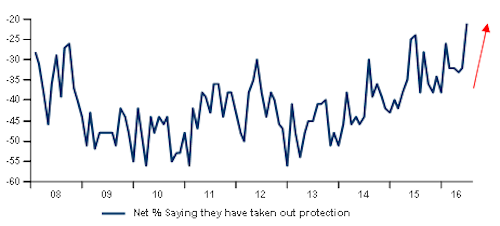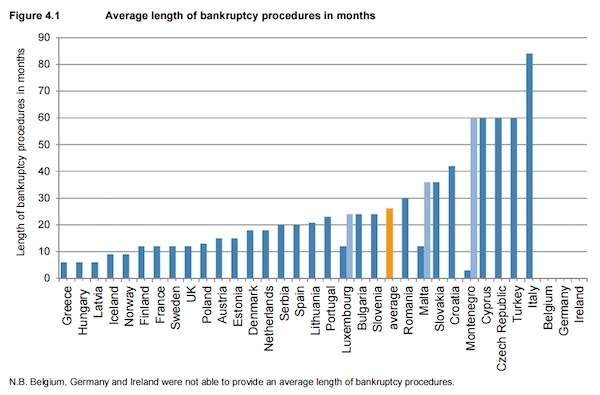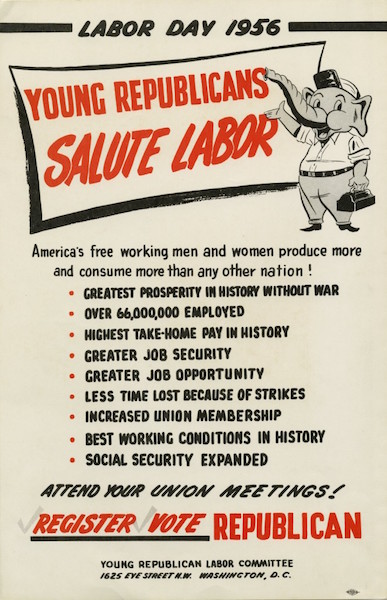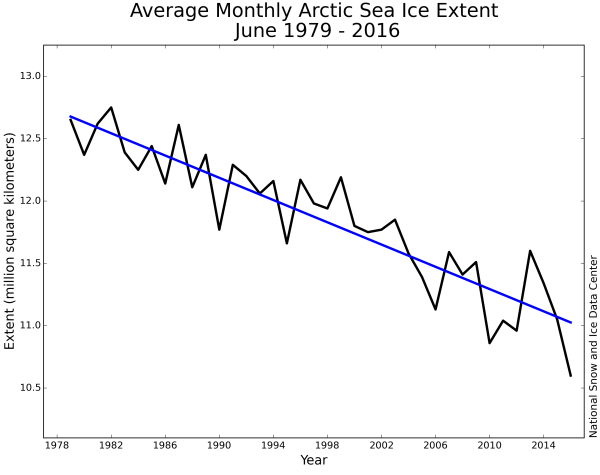
Harris&Ewing Newsie, Washington DC 1920

Breaking point.
• To the Mattresses: Cash Levels Highest In Nearly 15 Years (CNBC)
Despite the post-Brexit market rally, fund managers have gotten even more wary of taking risks. The S&P 500 has jumped about 8.5% since the lows hit in the days after Britain’s move to leave the EU, but that hasn’t assuaged professional investors. Cash levels are now at 5.8% of portfolios, up a notch from June and at the highest levels since November 2001, according to the latest BofA Merrill Lynch Fund Manager Survey. In addition to putting money under the mattress, investors also are looking for protection, with equity hedging at its highest level in the survey’s history. Indeed, fear is running high as investors believe that global financial conditions are tightening, despite nearly $12 trillion of negative-yielding debt around the world and the U.S. central bank on hold perhaps until 2017.
In fact, fear is running so high that BofAML experts think that it’s helping fuel the recent market rally. “Record numbers of investors saying fiscal policy is too restrictive and the first underweighting of equities in four years suggest that fiscal easing could be a tactical catalyst for risk assets going forward,” Michael Hartnett, chief investment strategist, said in a statement. Positioning changed, with a rotation from euro zone, banks and insurance companies shifting to the U.S., industrials, energy, technology and materials stocks. Fund managers believe that so-called helicopter money will become a reality, with 39% now anticipating the move compared to 27% in June.


“..the total sum of negative-yielding debt in the world has increased in the last sixteen days alone by an amount that’s larger than the entire GDP of Russia.”
• The Financial System Is Breaking Down At An Unimaginable Pace (Black)
Now it’s $13 trillion. That’s the total amount of government bonds in the world that have negative yields, according to calculations published last week by Bank of America Merrill Lynch. Given that there were almost zero negative-yielding bonds just two years ago, the rise to $13 trillion is incredible. In February 2015, the total amount of negative-yielding debt in the world was ‘only’ $3.6 trillion. A year later in February 2016 it had nearly doubled to $7 trillion. Now, just five months later, it has nearly doubled again to $13 trillion, up from $11.7 trillion just over two weeks ago. Think about that: the total sum of negative-yielding debt in the world has increased in the last sixteen days alone by an amount that’s larger than the entire GDP of Russia.
Just like subprime mortgage bonds from ten years ago, these bonds are also toxic securities, since many of are issued by bankrupt governments (like Japan). Instead of paying subprime home buyers to borrow money, investors are now paying subprime governments. And just like the build-up to the 2008 subprime crisis, investors are snapping up today’s subprime bonds with frightening enthusiasm. We’ll probably see $15 trillion, then $20 trillion, worth of negative-yielding subprime government debt within the next few months. So this trend will continue to grow for now, until, just like in 2008, the bubble bursts in cataclysmic fashion. It took several years for the first subprime bubble to pop. This one may take even longer. But even still, we can already see the consequences today.
A few months ago I told you about the remarkable $3.4 trillion funding gap in the US pension system. Remember, we’re not talking about Social Security– that has its own $40+ trillion shortfall. I’m talking about private companies’ retirement pensions, or public service worker pensions at the city and state level. (By the way, this is NOT strictly a US phenomenon. Europe suffers its own $2 trillion pension shortfall.) There’s zero mathematical probability that these pensions will be able to meet their obligations. They’re already underfunded. And the problem is getting worse, thanks in part to this plague of low and negative interest rates.

“Regardless of whether the November winner is Hillary or the Donald, there is one thing certain. There will be no functioning government come 2017.”
• This ‘Market’ Discounts Nothing Except Monetary Cocaine (Stockman)
[..]..whether the central banks buy public debt from the inventories of the 23 prime dealers and other market speculators or directly from the US treasury makes no technical difference whatsoever. The end state of “something for nothing” finance is the same in both cases. In fact, “helicopter money” is just a desperate scam emanating from the world’s tiny fraternity of central bankers who have walked the financial system to the brink, and are now trying to con the casino into believing they have one more magic rabbit to pull out of the hat. They don’t. That’s because it takes two branches of the state to tango in the game of helicopter money.
The unelected monetary central planners can run the digital printing presses at whim, and continuously “surprise” and gratify the casino gamblers with another unexpected batch of the monetary drugs. That has been exactly the pattern of multiple rounds of QE and the unending invention of excuses to prolong ZIRP into its 90th month. The resulting rises in the stock averages, of course, were the result of fresh liquidity injections and the associated monetary high, not the discounting of new information about economics and profits. By contrast, helicopter money requires the peoples’ elected representatives to play.
That is, the Congress and White House must generate large incremental expansions of the fiscal deficit—so that the central bankers can buy it directly from the US treasury’s shelf, and then credit the government’s Fed accounts with credits conjured from thin air. To be sure, the cynics would say – no problem! When have politicians ever turned down an opportunity to borrow and spend themselves silly, and to than be applauded, not chastised, for the effort? But that assumes we still have a functioning government and that today’s politicians have been 100% cured of their atavistic fears of the public debt. Alas, what is going to cause helicopter money to be a giant dud – at least in the US – is that neither of these conditions are extant.
Regardless of whether the November winner is Hillary or the Donald, there is one thing certain. There will be no functioning government come 2017.

Rewriting the law to save your banks?
• These Sicilian Mortgages Show How Hard It Is to Rescue Italian Banks (BBG)
Down the cobbled streets of Palermo, past baroque churches and gothic palaces, a lesson is lurking for Italy’s government as it hatches a plan to save the country’s banks. Sicily’s biggest city is the focal point of a 2007 securitization of non-performing loans, or NPLs, that shows just how long it can take to resolve soured loans in the country. The deal, known as Island Refinancing, should also act as a warning for investors of the dangers of buying similar securities as Italian banks gear up to sell more of them. The Island bonds are backed by two portfolios of NPLs originated by a Sicilian bank that’s now a subsidiary of UniCredit SpA. Just under half of the loans originated in the 1990s and they include residential mortgages as well as loans financing hotels and industrial buildings.
Unlike other asset-backed securities where interest and principal are paid through cash flows from mortgage or auto credit borrowers, investors in NPL securitizations depend on getting money back from soured loans – typically through the courts. And that’s where the problem lies. A court may auction the loan collateral and use the proceeds to pay the bonds, but that is a slow process. Italy is almost as well known these days for its sluggish and cumbersome insolvency procedures as it is for the Leaning Tower of Pisa or the AC Milan soccer club. Italian bankruptcy proceedings last an average of 7.8 years, compared to an average of just over two years for the rest of Europe.

Efforts are currently being made to speed up the process, with Prime Minister Matteo Renzi saying recent reforms to insolvency laws will shorten recovery times on NPL collateral to as little as six months. Still, the thus-far glacial pace of cash collections from NPLs has resulted in multiple credit ratings downgrades for the Island Refinancing deal, which will expire in 2025.

The time for trade deals is over.
• Deal With Canada On The Brink as German Party Sues EU Over CETA (Exp.)
Centre-left Die Linke has launched legal action to block the controversial Comprehensive Economic and Trade Agreement (CETA) pact, saying it is unconstitutional under German law. The party’s attempt to torpedo the hated deal is just the latest in a series of devastating trade blows for the EU, which is unravelling following the Brexit vote. And it reveals once more the cavernous differences opening up between different member states which have effectively rendered the European project unworkable. Earlier this month Canada’s despairing Trade Minister Chrystia Freeland asked: “If the EU cannot do a deal with Canada, I think it is legitimate to say who the heck can it do a deal with?”
But now there is a very real prospect that CETA will be torpedoed before it has even left port in a development which will throw the future of a much bigger deal with America into serious doubt. Negotiations over the Transatlantic Trade and Investment Partnership (TTIP) have ground to a halt, with impatient American officials warning Brussels to stop dragging their heels. The US chief negotiator said the proposed deal was nowhere near as enticing to Washington now that Britain has left the bloc, comparing a Europe without the UK to an America without California. Britain will not be affected by either calamity after voting to leave the EU, and is now free to begin informal talks on sealing its own trade deals with Canada, the US and the rest of the world.

Lincoln, too, was a Republican.
• The Long, Sad, Corrupted Devolution Of The GOP (Intercept)
In August 1956, the Republican Party gathered in San Francisco to re-nominate President Dwight D. Eisenhower as its candidate in the upcoming presidential election. The party that year adopted a platform that emphasized that the GOP was “proud of and shall continue our far-reaching and sound advances in matters of basic human needs.” This included boasting that Eisenhower had overseen a hike in the federal minimum wage that raised incomes for 2 million Americans while expanding Social Security to 10 million more people and increasing benefits for 6.5 million others.
Today’s Republican Party has made weakening labor unions a priority, but the 1956 platform noted that under Eisenhower, “workers have gained and unions have grown in strength and responsibility, and have increased their membership by 2 millions.” It also touted an increase in federal funding for hospital construction and expanded federal aid for health care for the poor and public housing. The platform also pointed out that Eisenhower had asked for “the largest increase in research funds ever sought in one year” to tackle ailments like cancer and heart disease. Rather than opposing self-governance for Washington, D.C., 1956’s Republicans encouraged it, saying they “favor self-government national suffrage and representation in the Congress of the United States” for those living there.
The platform also asked Congress to submit a constitutional amendment establishing “equal rights for men and women.” The platform boasted proudly of the African-Americans who had been appointed to positions in Eisenhower’s administration, and of ending racial discrimination in federal employment. At no point did the document call for any restrictions on immigration; rather, by contrast, it asked Congress to consider an extension of the 1953 Refugee Act, which brought tens of thousands of war-weary European refugees to American shores. Dwight D. Eisenhower was the face of the Republican Party in the 1950s. He had served as the supreme commander of the Allied forces as they retook Europe from fascist militaries in the decade before.
Experiencing two global wars shaped Eisenhower’s worldview, turning him into an advocate of peace. Eisenhower cut the military budget by 27% following the Korean War, and used his bully pulpit to highlight the trade-offs of military spending. “Every gun that is made, every warship launched, every rocket fired signifies, in the final sense, a theft from those who hunger and are not fed, those who are cold and are not clothed,” he said in a 1953 speech. In his farewell address on January 17, 1961, he highlighted the rise of what he called a “military-industrial complex” — a war industry that he cautioned could exert “undue influence” on the government.


When indeed?
• The World Is Taking Revenge Against Elites. When Will America’s Wake Up? (G.)
A snapshot of America in the middle of June 2016. It is several days before the first great shock of the summer, the Brexit vote, and here in America, all is serene. The threat posed by Senator Bernie Sanders has been suppressed. The Republicans have chosen a preposterous windbag to lead them; the consensus is that he will be a pushover. For all the doubts and dissent of the last year, the leadership faction of the country’s professional class seem to have once again come out on top, and they are ready to accept the gratitude of the nation. And so President Barack Obama did an interview with Business Week in which he was congratulated for his stewardship of the economy and asked “what industries” he might choose to join upon his retirement from the White House.
The president replied as follows: “… what I will say is that – just to bring things full circle about innovation – the conversations I have with Silicon Valley and with venture capital pull together my interests in science and organization in a way I find really satisfying.” In relating this anecdote, I am not aiming to infuriate because the man we elected in 2008 to get tough with high finance and shut the revolving door was now talking about taking his own walk through that door and getting a job in finance. No. My object here is to describe the confident, complacent mood of the country’s ruling class in the middle of last month. So let us continue. On the morning after British voters chose to leave the EU, Obama was in California addressing an audience at Stanford University, a school often celebrated these days as the pre-eminent educational institution of Silicon Valley.
The occasion of the president’s remarks was the annual Global Entrepreneurship Summit, and the substance of his speech was the purest globaloney, flavored with a whiff of vintage dotcom ebullience. Obama marveled at the smart young creative people who start tech businesses. He deplored bigotry as an impediment that sometimes keeps these smart creative people from succeeding. He demanded that more power be given to the smart young creatives who are transforming the world. Keywords included “innovation”, “interconnection”, and of course “Zuckerberg”, the Facebook CEO, who has appeared with Obama on so many occasions and whose company is often used as shorthand by Democrats to signify everything that is wonderful about our era.

“The law was seen as protecting the specialized securities firms from having to compete with large national banks..”
• The Secret History of Glass-Steagall (WSJ)
The Republican party platform calls for a revival of the Glass-Steagall Act, a depression-era banking law repealed in 1999. Glass-Steagall was the brainchild of Sen. Carter Glass (D-VA), best known as the principal architect of the Federal Reserve system. It erected a firewall between deposit-taking/loan-making banks and securities activities such as underwriting and trading. Its original goal was to prevent three things: purchasing of risky securities with government-insured deposits, extending bad loans to shaky companies owned by a bank, and pushing underwritten securities onto naïve bank customers. The provision became law when the Banking Act of 1933 was passed within days of President Franklin Roosevelt taking office in March 1933 in an effort to restore public confidence in the banking system.
The same act created the Federal Deposit Insurance Corp., which insures bank deposits, as well as the Federal Open Market Committee, the monetary policy making board of the Federal Reserve. The act also banned banks from paying interest on checking accounts and granted the Fed authority to put ceilings on interest rates offered for other deposits. Far from resisting Glass-Steagall, Wall Street securities firms embraced and became its most vocal supporters. The law was seen as protecting the specialized securities firms from having to compete with large national banks funded by cheap retail and commercial deposits.
The law was strengthened by a 1956 law that put bank holding companies under the purview of the Federal Reserve and made it clear they could not control both a commercial bank and an investment bank. As the years passed, however, the wall separating securities firms and banks developed cracks—primarily because of pressure from banks wanting to expand into securities dealing. Banks won regulatory approval for their affiliates to underwrite government securities, mortgage-backed securities and commercial paper. They were allowed to provide brokerage services to customers and market insurance. Banks began providing advice and assistance on mergers, acquisitions and financial planning. All this occurred without the law being changed.

The perks of decentralization.
• We Need More Borders And More States (Mises Inst.)
In the context of trade and immigration, borders are often discussed as a means of excluding foreign workers and foreign goods. In one way of thinking, borders provide an opportunity for states to exclude private actors such as workers, merchants, and entrepreneurs. On the other hand, borders can also serve a far more endearing function, and this is found in the fact that borders represent the limits of a state’s power. That is, while borders may exclude goods and people, a state’s borders also often exclude other states. For example, East Germany’s border with West Germany represented the limits of the East German police state, beyond which the power of the Stasi to kidnap, torture, and imprison peaceful people was far more limited than it was within its native jurisdiction.
The West German border acted to contain the East German state. Similarly, the borders of Saudi Arabia delineate a limit to the Saudi regime’s ability to behead people for sorcery or for making critical remarks about the blood-soaked dictators known as the House of Saud. Even within a single nation-state, borders can illustrate the benefits of decentralization, as in the case of the Colorado-Nebraska border. On one side of the border (i.e., Nebraska) state police will arrest you and imprison you for possessing marijuana. They may kill you if you resist. On the other side of the border, the state’s constitution prohibits police from prosecuting marijuana users. The Colorado border contains Nebraska’s war on drugs.
Certainly, there are ways for regimes to extend their power even beyond their borders. This can be done by cozying up with the regimes of neighboring countries (or intimidating them), or through the organs of international quasi-state organizations. Or, as in the case of the US and EU, imposing broader policies upon a number of supposedly sovereign states. Nevertheless, thanks to the competitive nature of states, many states will often find it difficult to project their power into neighboring states, and thus borders represent a very-real impediment to a state’s power. This can then open the door to greater freedom, and even save lives as certain states impoverish or make war on their own citizens.

When this streak is over everyone will think we’re safe.
• June 2016 Was 14th Consecutive Month Of Record-Breaking Heat (G.)
As the string of record-breaking global temperatures continues unabated, June 2016 marks the 14th consecutive month of record-breaking heat. According to two US agencies – Nasa and Noaa – June 2016 was 0.9C hotter than the average for the 20th century, and the hottest June in the record which goes back to 1880. It broke the previous record, set in 2015, by 0.02C. The 14-month streak of record-breaking temperatures was the longest in the 137-year record. And it has been 40 years since the world saw a June that was below the 20th century average.
The string of record-breaking monthly temperatures began in April 2015, and was pushed along by a powerful El Niño, where a splurge of warm water spreads across the Pacific Ocean. But the effects of El Niño have receded, and the effects of global warming are clear, said Nasa’s Gavin Schmidt. “While the El Niño event in the tropical Pacific this winter gave a boost to global temperatures from October onwards, it is the underlying trend which is producing these record numbers,” he said.

“..a Texas-sized chunk of sea ice has disappeared from our planet’s north pole between the early 1980s and today.”
• This Year’s Record Arctic Melt Is a Problem For Everybody (Stone)
If your life has felt like a hot mess this year, you’re not alone. Same goes for the Arctic, which month after month has seen its ice cover contract to new lows. By late September, Arctic sea ice may reach its lowest extent since satellite record-keeping began. And that’s got scientists in a tizzy, because if there’s one thing geologic history has taught us, it’s that sudden drops in Arctic ice cover are often the tip of the proverbial iceberg for a whole slew of planetary feedbacks. It’s difficult to keep up with all the climate-related records our world has been smashing, so here’s a quick recap of what’s been happening up north.
At the close of 2015 (currently the hottest year in recorded history, but not for long), the Arctic was already sweating iceberg-shaped bullets, thanks to freakishly warm weather brought on by a combination of a monster El Niño and the underlying global warming trend. Then 2016 burst on the scene, with temperatures at the North Pole rising some fifty degrees Fahrenheit above normal. The Arctic stayed exceptionally hot through January and February. By the time March rolled around, the atmosphere was loaded with heat, and Arctic sea ice was already starting to look thin. NASA confirmed that it was indeed the smallest wintertime Arctic sea ice extent on the record books, peaking at some 5.6 million square miles (14.5 million square km).
Then, the Arctic started to melt. And it kept going, and going, and going, smashing record after record, month after month. As of this writing, we’ve just come off the fifth record-low sea ice month this year. Every month except March has marked an all-time monthly low, with June sea ice maxing out a full 100,000 square miles (260,000 square kilometers) below the previous record low, set in 2010. June sea ice was also 525,000 square miles (1.36 million square km) below the 1981-2010 average. Put another way, a Texas-sized chunk of sea ice has disappeared from our planet’s north pole between the early 1980s and today.









